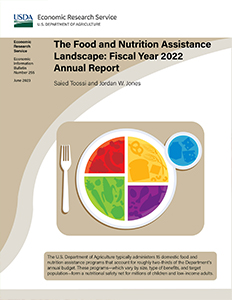The Food and Nutrition Assistance Landscape: Fiscal Year 2022 Annual Report
- by Saied Toossi and Jordan W. Jones
- 6/21/2023
Overview
The U.S. Department of Agriculture (USDA) administers 15 domestic food and nutrition assistance programs that affect the lives of millions of people and account for roughly two-thirds of USDA’s annual budget. In response to the Coronavirus (COVID-19) pandemic, USDA launched additional temporary programs and implemented numerous policy changes that expanded the scope and coverage of existing programs. Together, these programs contributed to $183 billion in spending on food and nutrition assistance programs in fiscal year (FY) 2022 (October 1, 2021–September 30, 2022). This report uses preliminary data from USDA, Food and Nutrition Service (FNS) to examine program trends and policy changes in USDA’s largest U.S. food and nutrition assistance programs through FY 2022. It also summarizes a recent USDA, Economic Research Service (ERS) report examining the prevalence of household food insecurity in the United States in 2021 and another USDA, ERS report examining changes in food choices in the USDA Foods program.
How to Cite:
Toossi, S., & Jones, J. W. (2023). The food and nutrition assistance landscape: Fiscal year 2022 annual report (Report No. EIB-255). U.S. Department of Agriculture, Economic Research Service. https://doi.org/10.32747/2023.8054020.ers
Download
-
Entire report
Download PDF -
Report Summary
Download PDF

